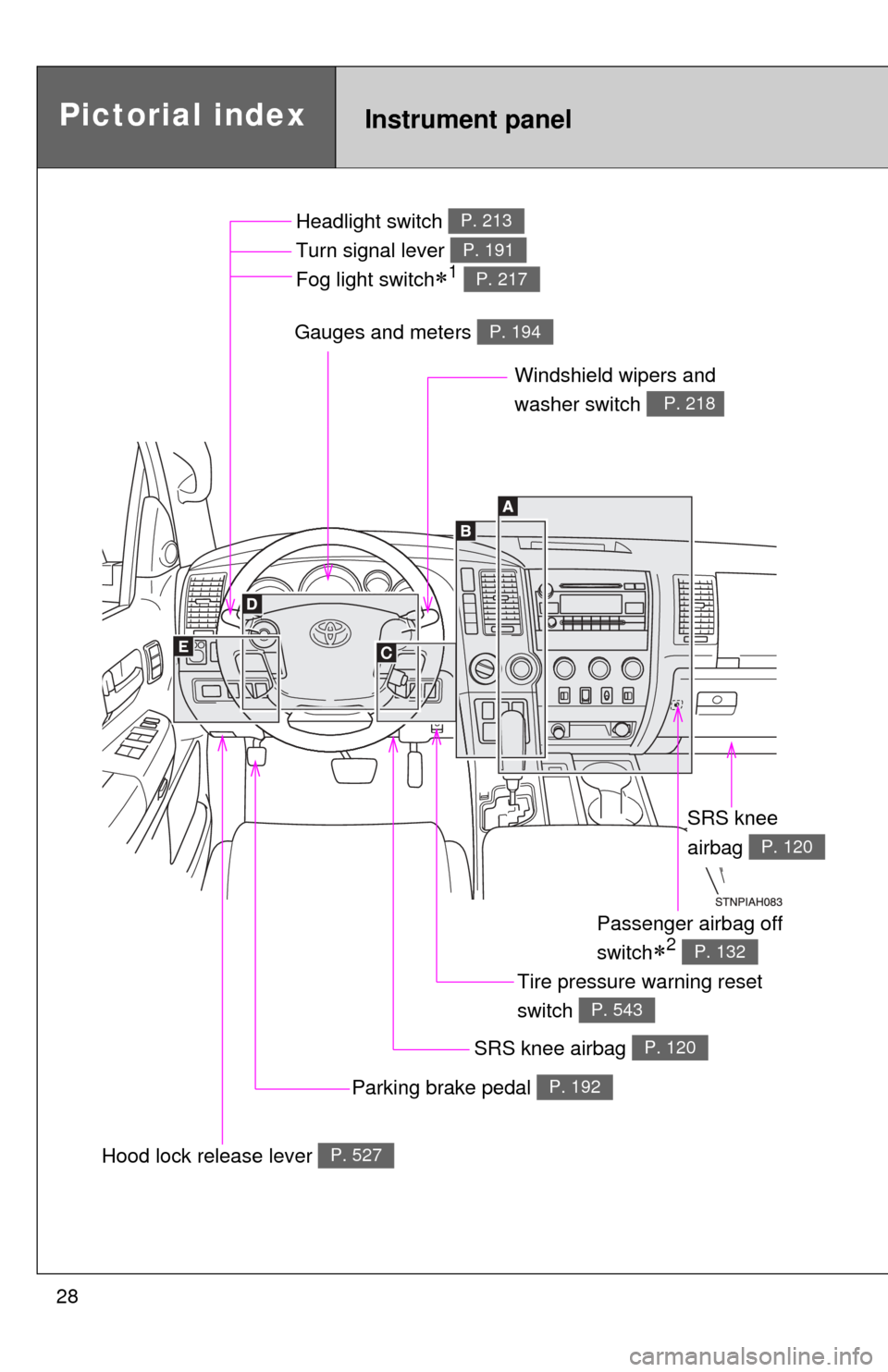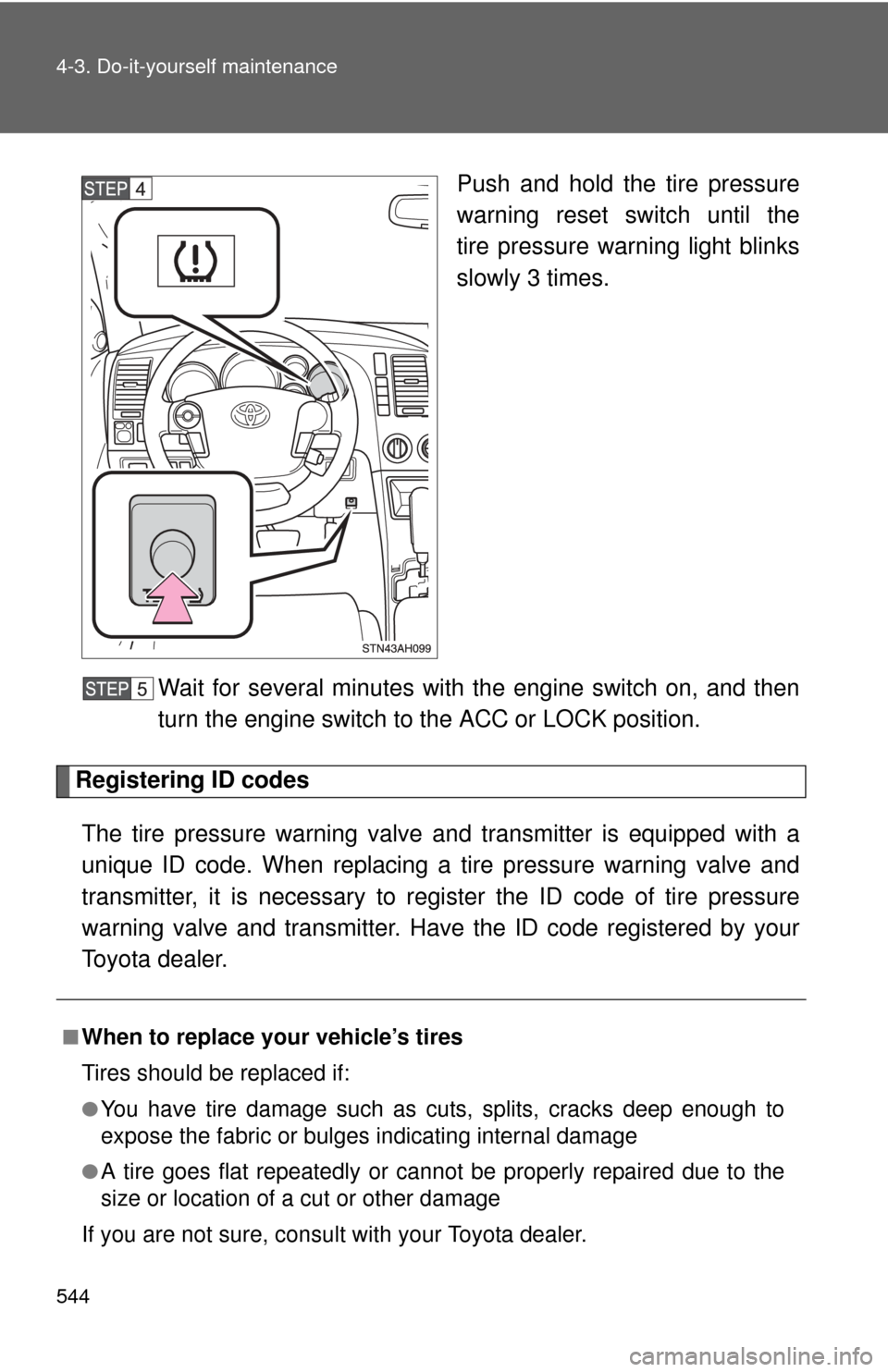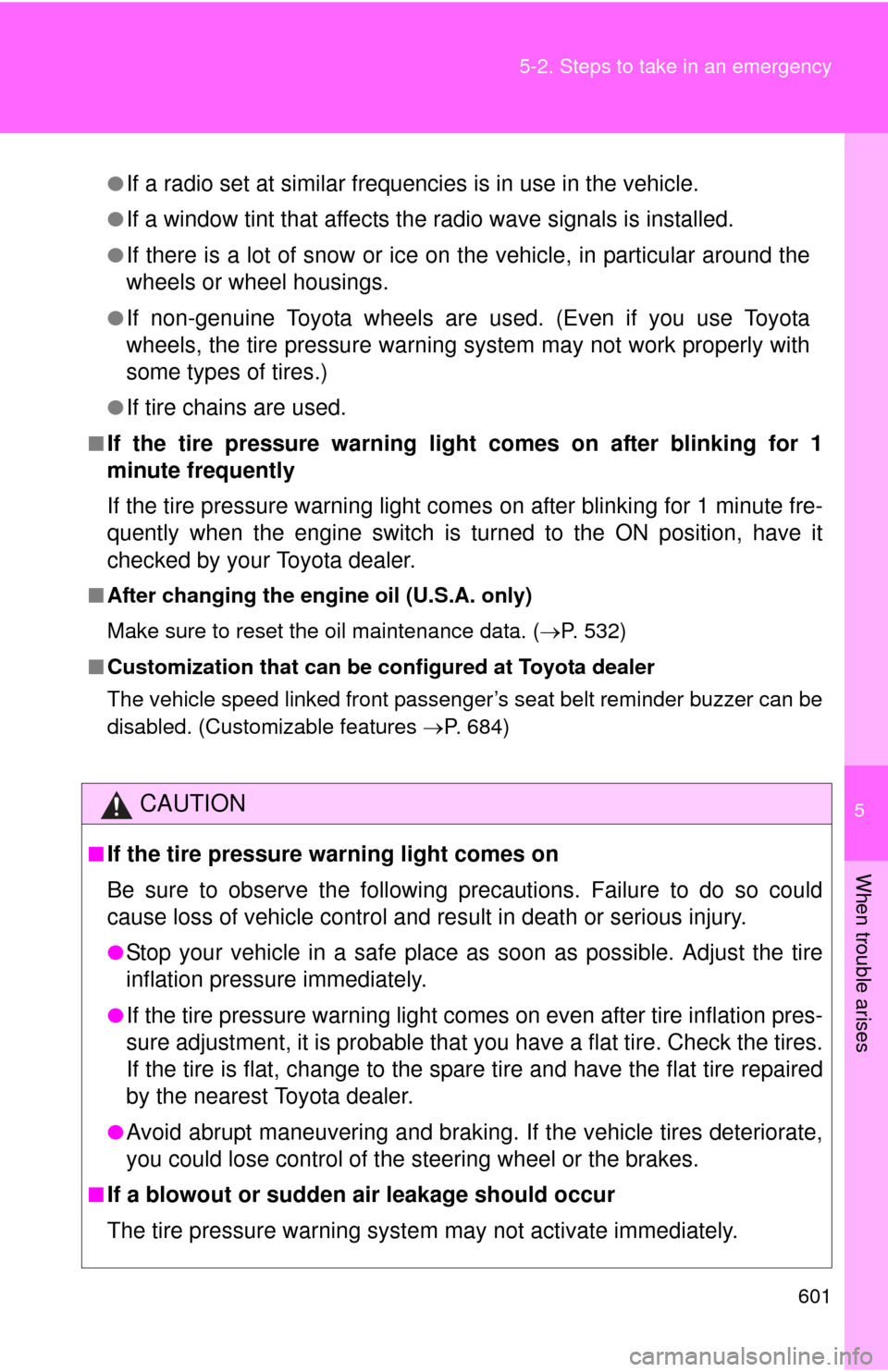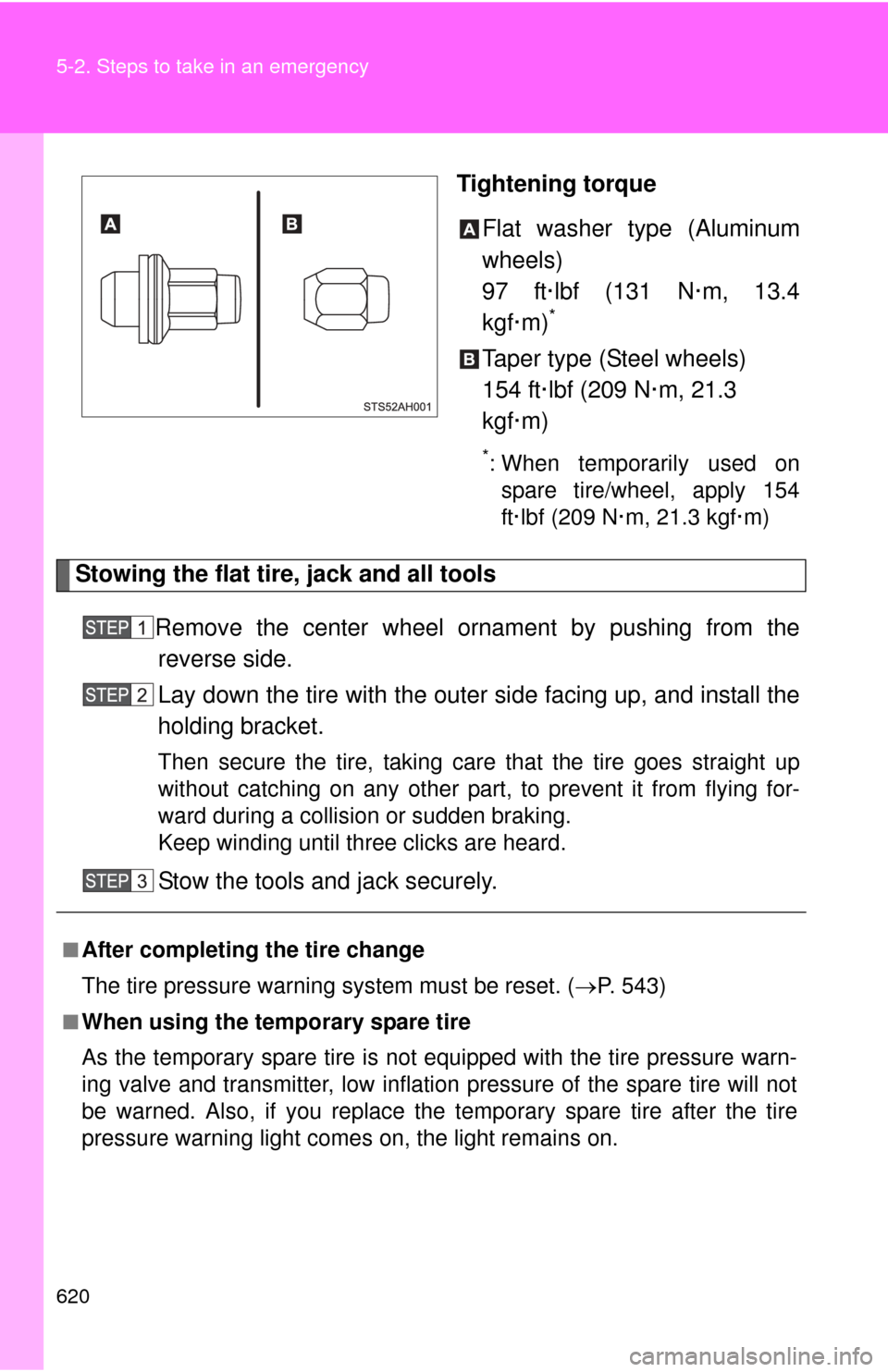2010 TOYOTA TUNDRA tire pressure reset
[x] Cancel search: tire pressure resetPage 28 of 724

28
Pictorial indexInstrument panel
Headlight switch
Turn signal lever
Fog light switch
1
P. 213
P. 191
P. 217
Windshield wipers and
washer switch
P. 218
Parking brake pedal P. 192
Gauges and meters P. 194
Hood lock release lever P. 527
Tire pressure warning reset
switch
P. 543
Passenger airbag off
switch
2 P. 132
SRS knee
airbag
P. 120
SRS knee airbag P. 120
Page 544 of 724

544 4-3. Do-it-yourself maintenance
Push and hold the tire pressure
warning reset switch until the
tire pressure warning light blinks
slowly 3 times.
Wait for several minutes with the engine switch on, and then
turn the engine switch to the ACC or LOCK position.
Registering ID codes
The tire pressure warning valve and transmitter is equipped with a
unique ID code. When replacing a tire pressure warning valve and
transmitter, it is necessary to regi ster the ID code of tire pressure
warning valve and transmitter. Have the ID code registered by your
Toyota dealer.
■When to replace your vehicle’s tires
Tires should be replaced if:
●You have tire damage such as cuts, splits, cracks deep enough to
expose the fabric or bulges indicating internal damage
●A tire goes flat repeatedly or c annot be properly repaired due to the
size or location of a cut or other damage
If you are not sure, consult with your Toyota dealer.
Page 546 of 724

546 4-3. Do-it-yourself maintenance
3Snow tiresFor driving on snow-covered roads or icy roads, we recommend using
snow tires. If you need snow tires, select tires of the same size, con-
struction and load capacity as the or iginally installed tires. Since your
vehicle has radial tires as original equipment, make sure your snow
tires also have radial construction. Do not install studded tires without
first checking local regulations for possible restriction. Snow tires
should be installed on all wheels. ( P. 260)
■Initializing the tire pr essure warning system
Initialize the tires with the tire inflati on pressure adjusted to the specified
level.
■If you push the tire pressure warning reset switch accidentally
If initialization is performed, adjust the tire in flation pressure to the speci-
fied level and initialize the tire pressure warning system again.
■When the initialization of the tire pressure warning system has
failed
Initialization can be completed in se veral minutes. However, in the fol-
lowing cases, the settings have not been recorded and the system will
not operate properly. If repeated attempts to record tire inflation pressure
settings are unsuccessful, have the vehicle inspected by your Toyota
dealer.
●When operating the tire pressure warning reset switch, the tire pres-
sure warning light does not flash 3 times.
●After carrying out the initialization procedure, the tire pressure warn-
ing light blinks for 1 minute and then stays on after driving for about
20 minutes.
■Routine tire inflation pressure checks
●The tire pressure warning system does not replace routine tire infla-
tion pressure checks. Make sure to check tire inflation pressure as
part of your routine of daily vehicle checks.
Page 548 of 724

548 4-3. Do-it-yourself maintenance
CAUTION
■When inspecting or replacing tires
●Do not use tires that have been used on another vehicle.
●Do not use tires if you do not know how they were used previously.
■When initializing the tire pressure warning system
●Do not push the tire pressure warning reset switch without first adjust-
ing the tire inflation pressure to th e specified level. Otherwise, the tire
pressure warning light may not come on even if the tire inflation pres-
sure is low, or it may come on when the tire inflation pressure is actu-
ally normal.
NOTICE
■Repairing or replacing tires, whee ls, tire pressure warning valves
and transmitters and tire valve caps
●When removing or fitting the wheels, tires or the tire pressure warning
valve and transmitter, contact your Toyota dealer as the tire pressure
warning valve and transmitter may be damaged if not handled cor-
rectly.
●When replacing tire valve caps, do not use tire valve caps other than
those specified. The cap may become stuck.
■To avoid damaging the tire pressure warning valves and transmit-
ters
Do not use liquid sealants on flat tires.
■Driving on rough roads
Take particular care when driving on roads with loose surfaces or pot-
holes.
These conditions may cause losses in tire inflation pressure, reducing
the cushioning ability of the tires. In addition driving on rough roads may
cause damage to the tires themselves, as well as the vehicle’s wheels
and body.
■If tire inflation pressures become low while driving
Do not continue driving, or your tires and/or wheels may be ruined.
Page 600 of 724

600 5-2. Steps to take in an emergency
The light will go off after taking several driving trips.
If the light does not go off even after several trips, contact your Toyota dealer
as soon as possible.
■ Front passenger detect ion sensor and passenger seat belt reminder
If luggage or other load is placed on the right front passenger seat, depend-
ing on its weight, the reminder light to flash and buzzer to sound.
■
When the tire pressure warning light comes on
Check the tire inflation pressure and adjust to the appropriate level.
Pushing the tire pressure warning reset switch does not turn off the tire
pressure warning light.
■The tire pressure warning light ma y turn on due to natural causes
The tire pressure warning light may turn on due to natural causes such
as natural air leaks or tire inflation pressure changes caused by temper-
ature. In this case, adjusting the ti re inflation pressure will turn off the
warning light (after several minutes).
■When a tire is replaced with a spare tire
The temporary spare tire is not equipped with the tire pressure warning
valve and transmitter. If a tire goes flat, the tire pressure warning light will
not turn off even though the flat tire is replaced with the temporary spare
tire. Replace the temporary spare tire with the repaired tire and adjust
the proper tire inflatio n pressure. The tire pres sure warning light will turn
off after several minutes.
■If the tire pressure warning system is inoperative
The tire pressure warning system will be disabled in the following condi-
tions:
(When the condition becomes normal, the system will work properly.)
●If tires not equipped with tire pressure warning valves and transmit-
ters are used.
●If the ID code on the tire pressure warning valves and transmitters is
not registered in the tire pressure warning computer.
The tire pressure warning system may be disabled in the following condi-
tions:
(When the condition becomes normal, the system will work properly.)
●If electronic devices or facilities using similar radio wave frequencies
are nearby.
Page 601 of 724

5
When trouble arises
601
5-2. Steps to take in an emergency
●If a radio set at similar frequencies is in use in the vehicle.
●If a window tint that affects the radio wave signals is installed.
●If there is a lot of snow or ice on
the vehicle, in particular around the
wheels or wheel housings.
●If non-genuine Toyota wheels are used. (Even if you use Toyota
wheels, the tire pressu re warning system may not work properly with
some types of tires.)
●If tire chains are used.
■If the tire pressure warning light comes on after blinking for 1
minute frequently
If the tire pressure warning light comes on after blinking for 1 minute fre-
quently when the engine switch is turned to the ON position, have it
checked by your Toyota dealer.
■ After changing the engine oil (U.S.A. only)
Make sure to reset the oil maintenance data. ( P. 532)
■ Customization that can be co nfigured at Toyota dealer
The vehicle speed linked front passenger’s seat belt reminder buzzer can be
disabled. (Customizable features P. 684)
CAUTION
■If the tire pressure warning light comes on
Be sure to observe the following precautions. Failure to do so could
cause loss of vehicle control and result in death or serious injury.
●Stop your vehicle in a safe place as soon as possible. Adjust the tire
inflation pressure immediately.
●If the tire pressure warning light comes on even after tire inflation pres-
sure adjustment, it is pr obable that you have a flat tire. Check the tires.
If the tire is flat, change to the spare tire and have the flat tire repaired
by the nearest Toyota dealer.
●Avoid abrupt maneuvering and braking. If the vehicle tires deteriorate,
you could lose control of the steering wheel or the brakes.
■If a blowout or sudden air leakage should occur
The tire pressure warning syste m may not activate immediately.
Page 620 of 724

620 5-2. Steps to take in an emergency
Tightening torqueFlat washer type (Aluminum
wheels)
97 ft·lbf (131 N·m, 13.4
kgf·m)
*
Taper type (Steel wheels)
154 ft·lbf (209 N·m, 21.3
kgf·m)
*: When temporarily used onspare tire/wheel, apply 154
ft·lbf (209 N·m, 21.3 kgf·m)
Stowing the flat tire, jack and all tools
Remove the center wheel ornament by pushing from thereverse side.
Lay down the tire with the outer side facing up, and install the
holding bracket.
Then secure the tire, taking care that the tire goes straight up
without catching on any other part, to prevent it from flying for-
ward during a collisi on or sudden braking.
Keep winding until three clicks are heard.
Stow the tools and jack securely.
■After completing the tire change
The tire pressure warnin g system must be reset. ( P. 543)
■When using the temporary spare tire
As the temporary spare tire is not equipped with the tire pressure warn-
ing valve and transmitter, low inflation pressure of the spare tire will not
be warned. Also, if you replace the temporary spare tire after the tire
pressure warning light comes on, the light remains on.
Page 715 of 724

715
Alphabetical index
Side mirrors
Adjusting and folding .............. 91
Mirror position memory........... 70
Spare tire Inflation pressure .................. 666
Replacing ............................. 616
Storage location ................... 608
Spark plug................................ 662
Specifications .......................... 640
Speedometer ........................... 194
SRS airbags
Curtain shield airbags........... 120
Front airbags ........................ 120
Knee airbags ........................ 120
Passenger airbag off switch ................................. 132
Precautions .......................... 127
Roll sensing of curtain shield
airbag off switch ................. 134
Side airbags ......................... 120
Steering Column lock release ............... 85
Steering wheel
Adjustment ............................. 85
Audio switches ..................... 358
Steering wheel memory.......... 70
Telephone switches.............. 418
Stop lights Replacing light bulbs ............ 577
Wattage ................................ 668
Storage feature ........................ 447
Storage precautions ............... 257
Stuck If your vehicle becomes stuck................................... 637
Sun visors ................................ 474
Switch Cruise control switch ............ 221
Emergency flasher switch .... 584
Engine switch ....................... 183
Fog light switch..................... 217
Front-wheel drive control
switch ................................. 236 Ignition switch........................183
Light switches........................213
Hazard light switch ................584
Headlights switch ..................213
Passenger airbag off
switch ..................................132
Power back window switch ...101
Power door lock switch ...........48
Power window switch ..............96
Roll sensing of curtain shield airbag off switch .................. 134
Tire pressure warning reset switch .........................543
TOW/HAUL switch ................189
Turn signal lights ...................191
VSC OFF switch ..........240, 245, 246, 247
Window lock switch .................98
Wiper and washer switch ......218
Tachometer...............................194
Tailgate Removing the tailgate .............53
Tailgate ...................................52
Tail lights
Replacing light bulbs .............577
Switch....................................213
Wattage .................................668
Talk switch................................418
Telephone switch .....................418
Theft deterrent system Alarm .....................................116
Engine immobilizer system ... 114
Tire inflation pressure .............549
Tire information
Glossary ................................678
Size .......................................675
Tire identification number ......674
Uniform tire quality grading ................................676
Tires Chains ...................................261
T